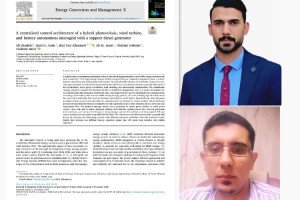
Assistant Lecturer Ali Shamkhi Hashim, Professor Dr. Basil Hani Jassim, and Dr. Ali Mohammed Jassim, faculty members in the Electrical Engineering Department at the College of Engineering, University of Basrah, published a joint research paper titled "Centralized Control System for a Hybrid Microgrid Composed of Photovoltaic Cells, Wind Turbines, and a Battery with Support from a Diesel Generator" in the international journal Energy Conversion and Management: X. The journal is indexed in Scopus in the first quartile (Q1).
It is indexed in Web of Science (ESCI) and has an Impact Factor of approximately 7.6 and a cite score of 11.3.
The significant interest in standalone microgrids indicates the increasing prevalence and availability of renewable energy resources. An energy storage system (ESS) is integrated into an isolated microgrid to ensure a balance between generation and consumption and to regulate the unpredictable behavior of renewable energy resources. This paper proposes a centralized management system based on a coordination strategy to provide tasks such as System-on-a-Chip (SoC) equalization, active power reduction, load shearing, and mismatch compensation. The coordination strategy should consider the limitations of energy storage systems to prevent their degradation. It also ensures a balance between generation and operation in different scenarios. Active power reduction is proposed to prevent battery overcharging when the SoC reaches 100% during charging, and a load shearing algorithm disconnects non-critical loads when the SoC reaches its minimum of 60% to prevent deep battery discharge. The proposed strategy includes a SoC algorithm for battery SoC equalization to ensure uniform charging/discharging across different batteries, regardless of their capacities. If all these resources are insufficient to meet load requirements, the proposed strategy is coupled to a diesel generator to ensure power balance in small power systems. These tasks aim to ensure the stability and reliability of the small electrical grid, optimal power flow between generating units and loads, and increased lifespan of energy storage systems. The validity of the proposed Energy Management System (EMS) architecture and control was tested using MATLAB/Simulink. The results demonstrate the effectiveness of the proposed EMS during charging and discharging under various operating conditions. Specifically, the equation-matching time between two batteries with different capacities is 10% longer than between batteries with similar capacities.
https://www.sciencedirect.com/science/article/pii/S2590174525005197








